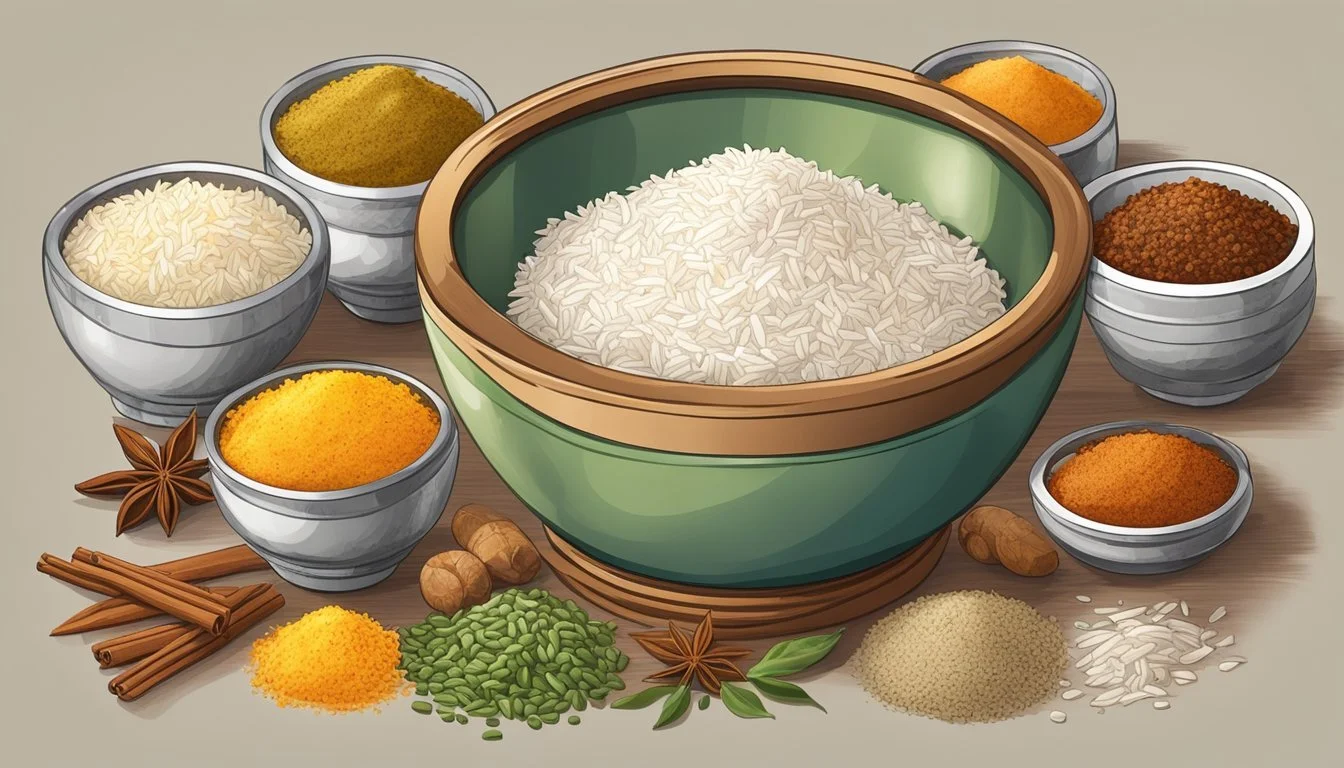Basmati Rice Substitutes
Top Alternatives for Cooking
Basmati rice, known for its distinct aroma, fluffy texture, and delicate flavor, is a staple in many kitchens around the world. Yet, there are times when you may need a suitable substitute due to availability or dietary preferences. One excellent substitute is long-grain brown rice, which retains the germ and bran, offering a healthier alternative without sacrificing the long, slender grain that resembles Basmati.
Kalijeera rice, also known as "baby basmati" from Bangladesh, provides a quick-cooking option with a similarly nutty flavor and fluffy texture. Its smaller grains make it ideal for those who love the essence of Basmati but need a faster preparation time. Another popular substitute is jasmine rice, which, despite its slightly stickier texture, shares a similar fragrant aroma that can enhance your dishes.
Exploring regional varieties, yellow rice introduces a vibrant twist with its saffron and turmeric-infused hue. This option not only mimics the long grain structure of Basmati but also adds a burst of flavor and color to your meals, making it a visually and gastronomically appealing alternative.
Understanding Basmati Rice
Basmati rice is a unique type of long-grain rice known for its aromatic and nutty flavor, as well as its distinct floral scent. Its origins trace back to the Himalayan region, and it plays a significant role in Indian cuisine.
Characteristics of Basmati Rice
Basmati rice stands out due to its long, slender grains which remain separate and fluffy when cooked. This rice variety offers a unique aroma, often described as a floral scent, and a nutty flavor that distinguishes it from other types of rice. Another notable feature is its low starch content, contributing to a lighter, more digestible texture. The grains are also known to elongate significantly during cooking, almost doubling in length.
Culinary Uses of Basmati Rice
Basmati rice is a staple in many dishes, particularly in Indian cuisine. It is frequently used in biryanis, pilafs, and as a side dish to complement curries and stews. This rice type is versatile and can absorb various flavors, making it an excellent base for a wide range of recipes. It pairs well with both savory and sweet ingredients, allowing chefs to experiment with diverse culinary creations. The rice is often cooked using a 1:1.5 ratio of rice to water, enhancing its unique texture and flavor.
Reasons to Substitute Basmati Rice
There are various reasons one might choose to substitute basmati rice including health concerns, cost issues, and flavor preferences. Different alternatives can cater to specific needs such as reducing carbohydrate intake, managing dietary restrictions, and enhancing the taste profile of a dish.
Health Considerations
Health benefits play a significant role in deciding whether to switch from basmati rice to another type of grain. For those looking for higher fiber content, long-grain brown rice can be an excellent substitute. Brown rice retains its bran and germ, making it a whole grain rich in fiber and essential nutrients.
For individuals on a low-carb diet, options like cauliflower rice or quinoa offer lower carbohydrate content while still providing a satisfying texture. Quinoa also supplies a complete protein source, essential for anyone following a diet that restricts animal protein intake.
Additionally, some people may have dietary restrictions such as gluten intolerance, and while basmati rice is naturally gluten-free, they might prefer substitutes like amaranth or millet, which offer varied nutrients and textures.
Economic Factors
The cost and availability of basmati rice can vary greatly depending on the region. In some areas, basmati rice might be expensive or hard to find, leading consumers to look for more economical options.
Long-grain white rice is widely available and often more affordable, making it a practical substitute. Short-grain rice or jasmine rice can also serve as cost-effective alternatives, especially in regions where these types are more commonplace and thus cheaper.
Buying in bulk or choosing locally produced rice varieties can also help in cutting down expenses. Substitutes like farro or barley may not only be more budget-friendly but also often come packed with added nutritional benefits.
Flavor Preferences
Flavor preferences are another significant reason people might seek basmati rice substitutes. While basmati rice is known for its aromatic quality and fluffy texture, some might prefer alternatives that align better with their recipes or personal taste.
Jasmine rice offers a similarly aromatic profile with a somewhat sweeter taste, making it suitable for those who enjoy fragrant rice but want a slightly different flavor. Yellow rice, flavored with spices like saffron or turmeric, provides a vibrant, spiced alternative that can enhance the overall taste of a dish.
Kalijeera rice, often referred to as "baby basmati," provides a unique, slightly nutty flavor and cooks quickly, becoming a great option for those who like basmati's taste but need a faster-cooking grain. This flexibility in flavors allows cooks to experiment and find the perfect match for their culinary creations.
Rice Alternatives to Basmati
When Basmati rice is unavailable, alternative types can offer different flavors, textures, and nutritional benefits. Below are some of the best substitutes and their unique qualities.
Jasmine Rice: A Fragrant Choice
Jasmine rice, a long-grain variety, is known for its fragrant aroma and slightly sticky texture. This rice originates from Thailand and complements a variety of Asian dishes. Unlike Basmati, Jasmine rice has a floral scent and a soft, moist consistency when cooked. Long-grain Jasmine rice maintains its fragrance due to natural aromatic compounds. It pairs well with curries, stir-fries, and grilled meats. Though it lacks the nutty flavor of Basmati, it offers a subtly sweet taste that enhances many recipes. Jasmine rice cooks quickly, typically ready in 15-20 minutes.
Brown Rice: Nutritious and Fiber-Rich
Brown rice is a healthier alternative, retaining the germ and bran, which are removed in white rice processing. Long-grain brown rice is especially versatile, providing a chewy texture and nutty flavor. It is rich in fiber, vitamins, and minerals, making it a nutritious choice for health-conscious individuals. Brown rice requires a longer cooking time, usually around 40-45 minutes, and may need additional water. It works well in salads, bowls, and as a side dish for hearty meals. For those seeking a healthier substitute with a robust texture, long-grain brown rice is ideal.
Wild and Other Specialty Rices
Wild rice, a semi-aquatic grass, offers a distinctively earthy flavor and chewy texture. It is high in protein and fiber, making it another nutritious option. Cooking wild rice typically takes about 45-60 minutes, with a water-to-rice ratio of 3:1. Other specialty rices like Kalijeera (baby Basmati), Texmati rice, and Popcorn rice provide unique alternatives. Kalijeera rice cooks quickly and offers a subtle nutty flavor, making it suitable for quick meals. Texmati, an American hybrid, blends the traits of Basmati and long-grain white rice, offering versatility. Popcorn rice has a mildly nutty flavor similar to Basmati and is suitable for various dishes. For those exploring different flavors and textures, these specialty rices provide diverse options.
Grain Alternatives to Basmati
Various grain alternatives to Basmati rice are available, each offering unique nutritional benefits and distinct cooking properties. These alternatives provide options for different dietary needs and preferences while maintaining versatility in cooking.
Quinoa: High-Protein Option
Quinoa is renowned for its high protein content, making it an excellent choice for those seeking to boost their protein intake. Unlike many grains, it contains all nine essential amino acids, making it a complete protein. Its nutty flavor and slightly chewy texture complement a variety of dishes.
Quinoa is also a good source of fiber, which aids digestion, and antioxidants, which contribute to overall health. Cooking quinoa is straightforward — it generally requires a 2:1 water-to-grain ratio and can be ready in about 15 minutes. Its versatile nature allows it to be used in salads, as a side dish, or even in soups.
Bulgur Wheat: High-Fiber Substitute
Bulgur wheat is an excellent high-fiber substitute for Basmati rice. Known for its quick cooking time, it retains a slightly nutty taste and chewy texture. Bulgur wheat is produced from cracked whole wheat kernels and is commonly used in Middle Eastern cuisine.
This grain is packed with dietary fiber, supporting digestive health, and can help manage blood sugar levels. It also provides several vitamins and minerals, including iron and magnesium. To cook bulgur wheat, simply combine it with boiling water and let it sit until absorbed, which usually takes about 10-15 minutes. It’s perfect for salads such as tabbouleh or as an alternative to rice in pilafs and casseroles.
Couscous: Quick-Cooking Alternative
Couscous, specifically made from semolina wheat, is a convenient and quick-cooking alternative. It has a mild flavor and a light, fluffy texture. Couscous is rich in selenium, an antioxidant that helps protect cells from damage and supports immune function.
This grain cooks in just a few minutes by adding boiling water or broth and letting it steam. Its fast preparation time makes it a favorite for quick meals. Couscous can be used in many recipes where Basmati rice might be used, such as in stews, salads, or as a simple side dish dressed with herbs and lemon juice.
Non-Rice Substitutes
For those seeking alternatives to Basmati rice that do not involve grains, numerous nutritious options exist. These substitutes are especially appealing to those aiming for low-carb or gluten-free diets.
Cauliflower Rice: Low-Carb Favorite
Cauliflower rice stands out as a popular vegetable substitute. It is made by grating or processing cauliflower into small, rice-like pieces. This alternative is not only low in carbohydrates but also packed with vitamins C and K.
Cooking cauliflower rice is simple. It can be sautéed with a bit of olive oil, garlic, and seasonings until tender. This brings out a slightly nutty flavor, making it a versatile base for many dishes. Its neutral taste allows it to pair well with a variety of flavors and ingredients. Cauliflower rice is gluten-free, making it suitable for those with gluten sensitivities.
Overall, it is an excellent choice for anyone looking to maintain a nutritious, low-carb diet without sacrificing taste.
Cooking with Rice Substitutes
When cooking with rice substitutes, it's essential to adjust the water ratios and cooking times appropriately. Understanding the texture and flavor of different rice types ensures the best culinary results.
Adjusting Water Ratios and Cooking Times
Each rice substitute has specific water requirements and cooking durations. Long-grain brown rice, for example, typically needs more water compared to white rice. A common ratio is 2.5 cups of water per cup of brown rice. Cooking time is also longer, approximately 40-45 minutes.
Jasmine rice, another substitute, requires a 1:1.5 water-to-rice ratio and cooks in about 15-20 minutes. This is similar for popcorn rice. Quinoa, a non-rice option, needs a 2:1 water-to-quinoa ratio and cooks in around 15 minutes. Using a rice cooker simplifies water management and ensures consistent results.
Texture and Flavor Considerations
Different rice substitutes provide varied textures and flavors. Long-grain brown rice offers a nutty taste and chewy texture, compared to the fluffy texture of Basmati. Jasmine rice has a naturally sweet aroma and softer texture, making it ideal for dishes requiring fragrant rice.
Popcorn rice, known for its unique flavor, mirrors basmati’s fluffiness but with a hint of corn-like taste. Quinoa, on the other hand, provides a slight crunch and unique flavor profile while being easier on digestion. Adjusting cooking methods, such as soaking rice before cooking, can also enhance texture and flavor.
Incorporating Substitutes into Recipes
Using substitutes for basmati rice can elevate your cooking by introducing new flavors and textures. Whether preparing salads, pilafs, or stir-fries, certain alternatives blend well into various dishes.
Creating Flavorful Salads
Substitutes such as quinoa and long-grain brown rice are excellent for salads. They offer a pleasant texture and absorb dressings well.
For a citrusy kick, quinoa pairs beautifully with lime juice, cumin, and fresh herbs. Long-grain brown rice works well with vinaigrettes and roasted vegetables. Mixing in cooked grains with seasonal veggies, nuts, and soft cheeses can create a satisfying and nutritious meal.
Perfecting Pilafs and Biryani
For pilafs and biryani, jasmine rice and texmati rice are good substitutes. Jasmine rice retains a lovely aroma and fluffiness that mimics basmati.
In a pilaf, sauté the rice with onions and cumin, then cook with broth and saffron for added depth. Biryani benefits from texmati rice, which absorbs spices like turmeric and curry well. Layer it with marinated meats or vegetables, and finish with fried onions and nuts for texture.
Mastery in Fried Rice and Stir-Fries
For stir-fries, cauliflower rice and long-grain brown rice are versatile options. Both hold up well to high heat and sauces.
Cauliflower rice offers a low-carb alternative that soaks up soy sauce, lime, and sesame oil. Long-grain brown rice is sturdier and provides a nutty flavor that complements garlic, ginger, and stir-fried vegetables. Using these substitutes in fried rice ensures a hearty, flavorful dish.
Each substitute has its own unique properties that can enhance your culinary creations. Whether you're looking for something quick to cook, nutritious, or flavorful, there's an option to suit every recipe.
Adapting Seasonings and Spices
When substituting Basmati rice, adapting the seasonings and spices can help achieve similar or complementary flavors. Different substitutes may pair better with certain herbs and spices, ensuring a delightful culinary experience.
Matching Spices with Substitutes
While replacing Basmati rice, consider the flavor profile of the substitute. Long-grain brown rice benefits from spices like cardamom and turmeric, which can add depth and richness. For quinoa, a nutty flavor can be enhanced with a touch of saffron or cumin.
Cauliflower rice works well with mild flavors like ginger and garlic, maintaining its subtle taste. Kalijeera rice pairs excellently with sweet spices such as cinnamon and clove. Adjusting the spice mix ensures the substitute complements the dish effectively.
Herbs and Seasonings for Enhanced Aromas
Using fresh herbs can elevate the aroma and taste of rice substitutes. For a fragrant touch, try cilantro or mint with Jasmine rice. They bring out the rice’s delicate floral notes. For quinoa, consider adding rosemary or thyme for a robust flavor.
Basil and parsley can accentuate the lightness of cauliflower rice, while dill can add a fresh contrast to long-grain brown rice. Balancing the herbs with the base ingredient helps in achieving a harmonious taste and aroma.
Adapting these seasonings and spices carefully can ensure that your substitute not only fits the dish's needs but also enhances the overall flavor profile.
Practical Tips for Substituting Basmati Rice
When looking to replace Basmati rice, consider the substitute’s texture, flavor, and cooking time to ensure your dish remains delicious. Be mindful of storage and preparation techniques to maintain the quality of your chosen rice substitute.
Choosing the Right Substitute
Choosing the correct rice substitute involves comparing textures and flavors. Jasmine rice is an excellent option as it shares a similar long-grain structure and a slightly sweet aroma. Long-grain white rice can also be used, though it lacks Basmati's distinct nutty flavor.
Long-grain brown rice is a healthier alternative due to the presence of the germ and bran. For unique dishes, Kalijeera rice from Bangladesh, known as "baby Basmati," offers quick cooking times and a slightly nutty flavor which can mimic Basmati rice.
Storage and Preparation Tips
Proper storage of rice substitutes ensures freshness and quality. Store rice in an airtight container in a cool, dry place. For cooked leftover rice, refrigerate promptly to prevent spoilage and to maintain its texture.
When preparing these substitutes, rinsing the rice before cooking can remove excess starch, resulting in a fluffier texture. For extra flavor, use chicken broth or add spices such as cardamom or saffron during the cooking process to mimic Basmati's aroma.






